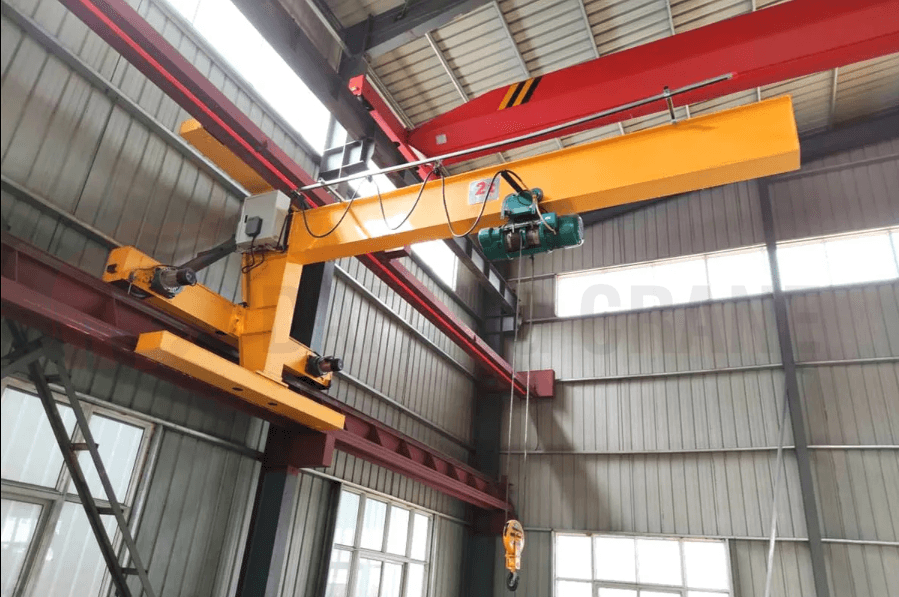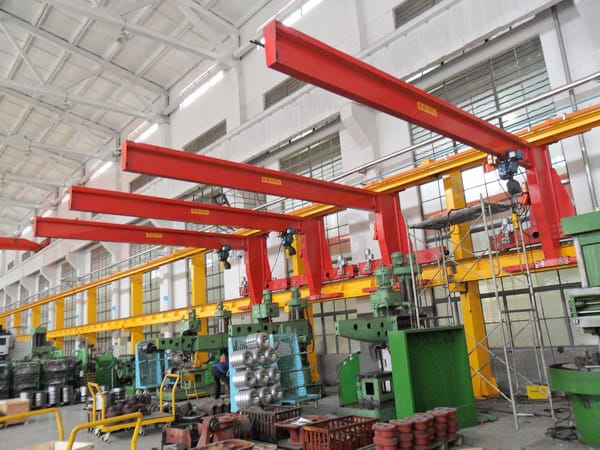Kren Jib Kembara Dinding: Cara Memilihnya
Apabila ia berkaitan dengan pengendalian bahan yang cekap dalam persekitaran industri, memilih peralatan yang betul adalah penting. Satu pilihan serba boleh untuk mengangkat dan mengalihkan beban berat ialah kren jib pengembara dinding. Dalam artikel ini, kami akan meneroka pelbagai aspek kren jib kembara dinding dan memberikan pandangan tentang cara memilih kren yang paling sesuai untuk keperluan khusus anda.
Gambaran Keseluruhan Kren Jib Perjalanan Dinding
Kren jib kembara dinding ialah peranti pengangkat khusus yang direka untuk menyediakan penyelesaian pengendalian bahan dan pengangkatan yang cekap dalam tetapan industri. Kren ini biasanya dipasang pada dinding atau lajur bangunan, membolehkan mereka melintasi secara mendatar sepanjang kawasan tertentu. Ia terdiri daripada lengan jib mendatar yang memanjang ke luar dan sistem troli untuk pergerakan lancar di sepanjang jib. Kren jib kembara dinding terkenal dengan fleksibiliti dan reka bentuk yang padat, menjadikannya ideal untuk digunakan di kawasan yang mempunyai ruang lantai yang terhad. Mereka menawarkan kebolehgerakan yang sangat baik dan boleh mengendalikan beban ringan hingga sederhana dengan mudah. Kren ini mendapat aplikasi dalam pelbagai industri, seperti pembuatan, gudang, talian pemasangan dan kemudahan penyelenggaraan, di mana ia membantu menyelaraskan operasi dengan menyediakan keupayaan mengangkat yang tepat dan terkawal berhampiran dengan kawasan kerja.

Faktor Yang Perlu Dipertimbangkan Apabila Memilih Kren Jib Kembara Dinding
- Kapasiti Beban: Faktor pertama dan terpenting yang perlu dipertimbangkan ialah kapasiti beban kren. Adalah penting untuk menilai berat maksimum beban yang perlu diangkat dengan kerap. Memilih kren dengan kapasiti beban yang sesuai memastikan operasi pengendalian bahan yang selamat dan cekap.
- Panjang Span: Panjang span merujuk kepada jarak yang diliputi oleh kren jib di sepanjang dinding. Ia ditentukan oleh ruang kerja yang tersedia dan kawasan liputan yang dikehendaki. Pertimbangan yang teliti harus diberikan kepada panjang rentang untuk memastikan bahawa kren boleh sampai ke semua lokasi yang dimaksudkan tanpa sebarang sekatan.
- Kelajuan dan Kawalan Angkat: The angkat kelajuan memainkan peranan penting dalam menentukan kecekapan operasi pengendalian bahan. Bergantung pada keperluan anda, anda mungkin memerlukan kren jib bergerak dinding dengan kelajuan angkat boleh laras. Selain itu, mempertimbangkan pilihan kawalan, seperti kawalan loket atau alat kawalan jauh, adalah penting untuk memudahkan operasi.
- Ciri Keselamatan: Keselamatan harus menjadi keutamaan apabila memilih mana-mana peralatan industri, termasuk kren jib bergerak dinding. Cari ciri seperti perlindungan beban lampau, butang berhenti kecemasan, suis had dan sistem antiperlanggaran. Langkah-langkah keselamatan ini membantu mencegah kemalangan dan melindungi kedua-dua kakitangan dan peralatan.
- Keperluan Pemasangan: Sebelum memilih kren jib kembara dinding, adalah penting untuk menilai keperluan pemasangan. Pertimbangkan faktor seperti struktur dinding, keperluan asas, dan sebarang pengubahsuaian tambahan yang mungkin diperlukan. Berunding dengan pemasang profesional boleh memastikan proses pemasangan yang lancar dan selamat.
Menilai Ruang Kerja

- Menilai Ruang Tersedia: Sebelum melabur dalam kren jib pengembara dinding, nilai ruang yang tersedia dalam kemudahan anda. Ambil kira ketinggian, lebar dan panjang kawasan di mana kren akan dipasang. Penilaian ini akan membantu menentukan saiz dan konfigurasi kren yang sesuai.
- Menganalisis Pertimbangan Struktur: Keutuhan struktur dinding atau bangunan di mana kren akan dipasang adalah penting untuk operasi yang selamat. Pastikan dinding boleh menahan berat dan tekanan yang dikenakan oleh kren dan beban yang akan dikendalikannya. Berunding dengan jurutera struktur boleh memberikan pandangan berharga tentang kebolehlaksanaan memasang kren jib kembara dinding.
Memilih Kren Jib Kembara Dinding Yang Tepat
Untuk memilih kren jib kembara dinding yang betul, anda perlu mengambil kira semua faktor yang disebutkan di atas dan menyelaraskannya dengan keperluan dan keperluan khusus anda:
Memadankan Kapasiti Beban Dengan Keperluan
Kapasiti beban merujuk kepada berat maksimum yang boleh diangkat oleh kren dengan selamat. Adalah penting untuk tidak memandang rendah atau melebihkan keperluan kapasiti beban anda. Taksir purata berat beban yang akan anda angkat dan pilih kren dengan kapasiti lebih tinggi sedikit untuk membolehkan potensi pertumbuhan masa hadapan. Ini memastikan operasi yang cekap dan selamat sambil memanjangkan jangka hayat kren.

Menentukan Panjang Span yang Sesuai
Seterusnya, anda perlu menentukan panjang rentang yang sesuai untuk kren jib pengembara dinding anda. Panjang rentang merujuk kepada jarak antara pusat putaran dan dinding. Pertimbangkan susun atur ruang kerja anda dan kawasan di mana kren akan digunakan. Ukur kawasan liputan yang diperlukan untuk memastikan kren boleh mencapai semua titik yang diperlukan. Pemilihan panjang rentang yang optimum membolehkan pergerakan lancar dan tidak terhad, memaksimumkan kecekapan operasi kren.
Mempertimbangkan Pilihan Kelajuan Dan Kawalan Hoist
Pilihan kelajuan dan kawalan angkat memainkan peranan penting dalam prestasi kren jib bergerak dinding. Nilaikan aliran kerja anda dan kelajuan bahan perlu diangkat dan diangkut. Pilih kren dengan kelajuan angkat berubah-ubah untuk menampung tugas yang berbeza. Selain itu, pertimbangkan pilihan kawalan yang tersedia, seperti kawalan loket butang tekan atau alat kawalan jauh radio. Ciri-ciri ini menyumbang kepada operasi kren yang tepat dan mudah, meningkatkan produktiviti dan keselesaan pekerja.
Memastikan Pematuhan Dengan Piawaian Keselamatan
Keselamatan hendaklah sentiasa menjadi keutamaan apabila memilih sebarang jenis peralatan mengangkat. Pastikan kren jib kembara dinding yang anda pilih mematuhi piawaian dan peraturan keselamatan industri. Cari pensijilan seperti pematuhan CE atau OSHA. Selain itu, pertimbangkan ciri keselamatan seperti perlindungan beban lampau, butang berhenti kecemasan dan suis had. Mengutamakan keselamatan bukan sahaja melindungi pekerja anda tetapi juga meminimumkan risiko kemalangan dan kerosakan peralatan.
Menyemak Keperluan Pemasangan
Sebelum memuktamadkan pilihan anda, semak keperluan pemasangan kren jib pengembara dinding. Pertimbangkan faktor seperti ruang yang tersedia, sokongan struktur dan bekalan kuasa. Rujuk dengan pemasang profesional untuk memastikan kren boleh dipasang dengan betul di kemudahan anda. Pemasangan yang betul menjamin prestasi optimum, jangka hayat dan pematuhan kepada piawaian keselamatan.
Soalan Lazim
- Mengapakah kelajuan angkat dan kawalan penting dalam kren jib bergerak dinding?
Kelajuan angkat mempengaruhi produktiviti dan kecekapan operasi. Memilih kren dengan kelajuan angkat yang sesuai memastikan pengangkatan dan penurunan beban yang cekap. Selain itu, pertimbangkan pilihan kawalan untuk memastikan pergerakan lancar dan tepat. - Apakah ciri keselamatan yang perlu saya cari semasa memilih kren jib kembara dinding?
Cari kren dengan ciri keselamatan yang teguh seperti perlindungan beban lampau, butang berhenti kecemasan, sistem mengelakkan perlanggaran dan penggera yang boleh didengar. Ciri-ciri ini membantu mengurangkan potensi risiko dan memastikan keselamatan pengendali dan kakitangan. - Bagaimanakah cara saya memilih kren jib kembara dinding yang betul berdasarkan keperluan saya?
Untuk memilih kren yang betul, anda perlu memadankan kapasiti beban khusus anda, panjang rentang, kelajuan angkat, pilihan kawalan, ciri keselamatan dan keperluan pemasangan dengan teliti kepada model kren yang tersedia. Analisis menyeluruh tentang faktor-faktor ini akan membantu anda memilih kren yang paling sesuai dengan keperluan anda.
Hantar Pertanyaan Anda
- e-mel: sales@hndfcrane.com
- WhatsApp: +86-191 3738 6654
- Tel: +86-373-581 8299
- Faks: +86-373-215 7000
- Tambah: Daerah Perindustrian Changnao, Bandar Xinxiang, Wilayah Henan, China







































































